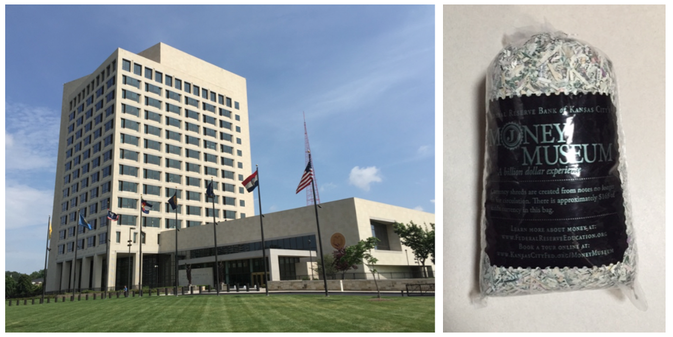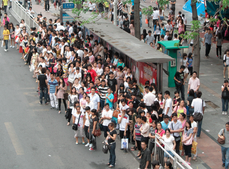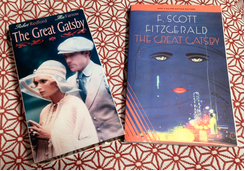Central Bank and 12 Regional Feds: Manipulating Today’s Economy (Page 3/3)
September 8, 2015
Akira Kondo
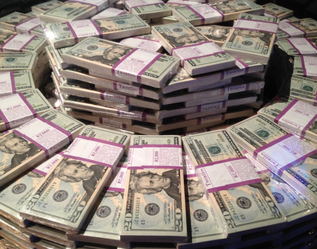 The twenty-dollar bills are nicely piled at the Money Museum of the Federal Reserve Bank of Chicago. The twenty-dollar bills are nicely piled at the Money Museum of the Federal Reserve Bank of Chicago.
Where is your money printed?
Today, you may see new Jackson or Franklin bills when you withdraw money from your favorite bank near your home or office. All those new bills have been printed in a past few years when the Fed manipulated massive (unconventional) expansionary monetary policy, known as QEs. In addition to such monetary policy that the central Fed manipulates, each of 12 regional Feds prints bills into circulation to local commercial banks. Thus, the Jackson bills that you often withdraw from your local ATM machine are most likely printed in your local Fed. An each bill has a number and a letter, like an each iPhone does. If you pull out a Jackson bill or any U.S. notes from your wallet, you will see, for instance, a number “12” and a letter “L” on the bill, which means this has been printed in San Francisco. Other letters and numbers indicate:
Interestingly, 11 of the 12 regional Feds are located from the Central America to the East Coast. San Francisco Fed covers most of the Western States as well as Alaska, Hawaii, and even Guam. According to New York Fed, “this size discrepancy relates to the population distribution in 1913 when the population was heavily concentrated along the East Coast.” Since California economy weighs about 15 percent of the U.S economy and its importance increases, it may need a new Fed in the West Coast in the future, though may not be necessary.
Can we get into Fed?
Although most Feds do not allow you to get into any of the buildings, some regional reserve banks, however, would like to welcome you to the building and let you learn what they are really doing. Again, you cannot withdraw any bills from the Fed, but you may grab a bag of shredded bills back home instead! While I have visited many Feds across the states, my best recommendation goes to New York Fed, which is the largest one, in terms of its assets and influence, among the 12 regional Feds. 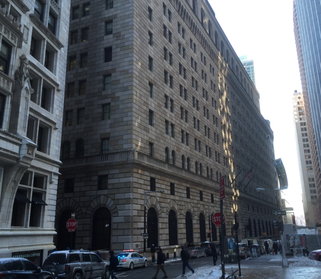 Federal Reserve Bank of New York Federal Reserve Bank of New York
New York Fed
New York Fed is the largest Federal Reserve Bank, and it is located in the lower Manhattan or a few blocks off from the Wall Street. This Fed allows you step into the building and offers a meaningful lecture-style group tour when you make a reservation online in advance. It is probably the best place to visit in New York if you are highly interested in economy and finance. While in the tour, you will learn the roles and responsibilities of New York Fed. The highlight of the tour is a brief visit to the New York Fed’s gold vault, which is located the basement, where you can see actual gold bars. Plus, you can really smell the gold. To get a spot for the tour, you need to reserve your spot online. The tour offers twice a day in a dairy basis as long as the bank is open. However, the spots are quickly running out once the next available reservation appears. Thus, you will need to reserve a spot in well advance or the first day of the month when the next month’s reservation system becomes available. On your day to New York Fed, be sure to bring your government-issued photo ID and the printed confirmation. Since you need to go through the tight security check, like an airport, you cannot bring your large backpack and etc. Website for Federal Reserve Bank of New York: http://www.newyorkfed.org 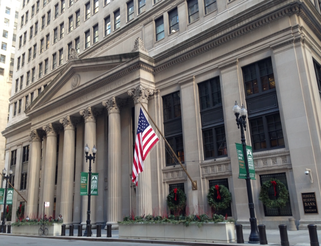 Federal Reserve Bank of Chicago and the Money Museum Federal Reserve Bank of Chicago and the Money Museum
Chicago Fed:
Since Chicago Fed is conveniently located in the downtown, it is easy to visit the Fed building by foot or the Loop. This Chicago Fed offers Money Museum for all ages as I had seen a group of primary school kids, who was touring the museum. This Money Museum teaches visitors a general idea of how the Federal Reserve System and the money work. The highlight of the Money Museum is that you can see one million dollars packed in a briefcase while the automated photography system would snap a picture of you and the million dollars together. Like New York Fed, you still need to have your ID to go through the security point while no reservation is needed to get into the Money Museum. Website for The Money Museum at the Federal Reserve Bank of Chicago: www.chicagofed.org Kansas City Fed:
Kansas City Fed is located a distance away from the downtown but is located just besides National World War I Museum and Memorial, where more tourists are probably interested. To get to the Kansas City Fed, the convenient way is to just drive down to the site while the complimentary parking lots are provided. Though you can still enjoy hiking the hill all the way to the Fed building from the downtown. It is about a mile walk depending on where in downtown you are staying. Like Chicago Fed, this Kansas City Fed also offers its Money Museum for visitors as long as the bank is open. In the museum, you will learn how the Fed and money work. Plus, you will learn some history of the Fed as well. The place you may want to see is the cash operation, where U.S. bills are newly printed and later those bills are shipped to local banks, such as Bank of America. Remember that money that printed in Kansas City Fed is marked with “10 J.” In addition, this Kansas City Fed offers some complimentary research periodicals and you may want to grab one if interested. Before exiting the Fed, be sure to grab a bag of shredded currency, which is worth about $600 (if you patiently fix them, plus if you are very lucky enough to have bills that have same serial numbers in the bag!). Importantly, you will need your ID to get into the museum.
Website for The Money Museum at the Federal Reserve Bank of Kansas City: https://www.kansascityfed.org/moneymuseum While I have visited many Feds across the states, it seems like San Francisco, St. Louis, and Minneapolis Feds were not open to public visitors. I have no idea about Boston, Dallas, Cleveland, and Atlanta Feds if they allow visitors in. However, it is worth stopping by one of 12 Feds if you are to visit one of those 12 cities whether it is business or leisure trip. If you are luckily visiting New York, Chicago, or Kansas City in the future, you should consider visiting the Fed. Again, be sure to make a reservation online if you are to visit New York Fed.
|
More on Economy<Previous Pages>
How is
|

